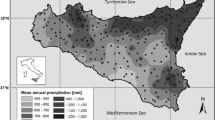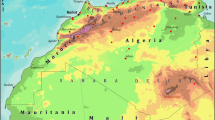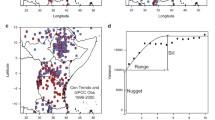Abstract
The present study investigates the century-long and more recent rainfall trends over the greater region of Middle East and North Africa (MENA). Five up-to-date gridded observational datasets are employed. Besides mean annual values, trends of six indices of drought and extreme precipitation are also considered in the analysis. Most important findings include the significant negative trends over the Maghreb, Levant, Arabian Peninsula, and Sahel regions that are evident since the beginning of the twentieth century and are more or less extended to today. On the other hand, for some Mediterranean regions such as the Balkans and the Anatolian Plateau, precipitation records during the most recent decades indicate a significant increasing trend and a recovering from the dry conditions that occurred during the mid-1970s and mid-1980s. The fact that over parts of the study region the selected datasets were found to have substantial differences in terms of mean climate, trends, and interannual variability, motivated the more thorough investigation of the precipitation observational uncertainty. Several aspects, such as annual and monthly mean climatologies and also discrepancies in the monthly time-series distribution, are discussed using common methods in the field of climatology but also more sophisticated, nonparametric approaches such as the Kruskal–Wallis and Dunn’s tests. Results indicate that in the best case, the data sources are found to have statistically significant differences in the distribution of monthly precipitation for about 50% of the study region extent. This percentage is increased up to 70% when particular datasets are compared. Indicatively, the range between the tested rainfall datasets is found to be more than 20% of their mean annual values for most of the extent of MENA, while locally, for the hyper-arid regions, this percentage is increased up to 100%. Precipitation observational uncertainty is also profound for parts of southern Europe. Outlier datasets over individual regions are identified in order to be more cautiously used in future regional climate studies.












Similar content being viewed by others
References
Almazroui M, Nazrul Islam M, Athar H, Jones PD, Rahman MA (2012) Recent climate change in the Arabian Peninsula: annual rainfall and temperature analysis of Saudi Arabia for 1978–2009. Int J Climatol 32(6):953–966. https://doi.org/10.1002/joc.3446
Beguería S, Vicente-Serrano SM, Tomás-Burguera M, Maneta M (2016) Bias in the variance of gridded data sets leads to misleading conclusions about changes in climate variability. Int J Climatol 36(9):3413–3422. https://doi.org/10.1002/joc.4561
Bergaoui K, Mitchell D, Zaaboul R, McDonnell R, Otto F, Allen M (2015) The contribution of human-induced climate change to the drought of 2014 in the southern Levant region [in “Explaining Extremes of 2014 from a Climate Perspective”]. Bull Am Meteorol Soc 96(12):S66–S70. https://doi.org/10.1175/BAMS -D-15-00129.1
Bocheva L, Marinova T, Simeonov P, Gospodinov I (2009) Variability and trends of extreme precipitation events over Bulgaria (1961–2005). Atmos Res 93(1):490–497. https://doi.org/10.1016/j.atmosres.2008.10.025
Camera C, Bruggeman A, Hadjinicolaou P, Pashiardis S, Lange MA (2014) Evaluation of interpolation techniques for the creation of gridded daily precipitation (1 × 1 km2); Cyprus, 1980–2010. J Geophys Res Atmos 119(2):693–712. https://doi.org/10.1002/2013JD020611
Chambers JM (1992) Linear models. In: Chambers JM, Hastie TJ (eds) Statistical Models in S. Wadsworth & Brooks/Cole, Pacific Grove
Chen M, Shi W, Xie P, Silva VBS, Kousky VE, Wayne Higgins R, Janowiak JE (2008) Assessing objective techniques for gauge-based analyses of global daily precipitation. J Geophys Res 113(D4):D04110+. https://doi.org/10.1029/2007JD009132
Chew FHS, McMahon TA (1996) Trends in historical streamflow records. In: Jones JAA, Changming L, Ming-Ko W, Hsiang-Te K (eds) Regional Hydrological Response to Climate Change. Kluwer Academic Publishers, Netherlands
Contractor S, Alexander LV, Donat MG, Herold N (2015) How Well Do Gridded Datasets of Observed Daily Precipitation Compare over Australia? Adv Meteorol 2015:325718. https://doi.org/10.1155/2015/325718
Corder GW, Foreman DI (2009) Nonparametric statistics for non-statisticians; A Step-by-Step Approach. John Wiley and Sons, Hoboken
Cook BI., Anchukaitis KJ, Touchan R, Meko DM, Cook ER (2016) Spatiotemporal drought variability in the Mediterranean over the last 900 years. J Geophys Res Atmos 121(5):2060–2074. https://doi.org/10.1002/2015jd023929
de Vries AJ, Feldstein SB, Tyrlis E, Riemer M, Baumgart M, Fnais Sprenger M, Lelieveld J (2016) Dynamics of tropical-extratropical interactions and extreme precipitation events in Saudi Arabia in autumn, winter and spring. Quart J Roy Meteor Soc 142:1862–1880. https://doi.org/10.1002/qj.2781
Dino A (2017) Dunn’s test of multiple comparisons using rank sums. Reference manual of R package “dunn.test”. https://cran.r-project.org/web/packages/dunn.test/dunn.test.pdf
Donat MG et al (2014) Changes in extreme temperature and precipitation in the Arab Region: long-term trends and variability related to ENSO and NAO. Int J Climatol 34(3):581–592. https://doi.org/10.1002/joc.3707
Dong B, Sutton R (2015) Dominant role of greenhouse-gas forcing in the recovery of Sahel rainfall. Nat Clim Chang 5(8):757–760. https://doi.org/10.1038/nclimate2664
Dunn OJ (1964) Multiple comparisons using rank sums. Technometrics 6:241–252
Funk C, Peterson P, Landsfeld M, Pedreros D, Verdin J, Shukla S, Husak G, Rowland J, Harrison L, Hoell A, Michaelsen J (2015) The climate hazards infrared precipitation with stations—a new environmental record for monitoring extremes. Sci Data 2:150066. https://doi.org/10.1038/sdata.2015.66
Georgoulias AK, Kourtidis KA, Alexandri G, Rapsomanikis S, Sanchez-Lorenzo A (2015) Common summertime total cloud cover and aerosol optical depth weekly variabilities over Europe: Sign of the aerosol indirect effects? Atmos Res 153:59–73. https://doi.org/10.1016/j.atmosres.2014.07.031
Gómez-Navarro JJ, Montávez JP, Jerez S, Jiménez-Guerrero P, Zorita E (2012) What is the role of the observational dataset in the evaluation and scoring of climate models? Geophys Res Lett 39(24):L24701. https://doi.org/10.1029/2012GL054206
Harris I, Jones PD, Osborn TJ, Lister DH (2014) Updated high-resolution grids of monthly climatic observations – the CRU TS3.10 dataset. Int J Climatol 34(3):623–642. https://doi.org/10.1002/joc.3711
Hoerling M, Eischeid J, Perlwitz J, Quan X, Zhang T, Pegion P (2012) On the increased frequency of Mediterranean drought. J Climate 25(6):2146–2161. https://doi.org/10.1175/JCLI-D-11-00296.1
Isotta FA, Vogel R, Frei C (2015) Evaluation of European regional reanalyses and downscalings for precipitation in the Alpine region. Meteorol Z 24:15–37. https://doi.org/10.1127/metz/2014/0584
Javari M (2016) Trend and homogeneity analysis of precipitation in Iran. Climate 4(3):44+. https://doi.org/10.3390/cli4030044
Kelley CP, Mohtadi S, Cane MA, Seager R, Kushnir Y (2015) Climate change in the fertile crescent and implications of the recent Syrian drought. Proc Natl Acad Sci 112(11):3241–3246. https://doi.org/10.1073/pnas.1421533112
Klein Tank AMG, Zwiers F, Zhang X (2009), Guidelines on analysis of extremes in a changing climate in support of informed decisions for adaptation, Climate data and monitoring wcdmp-no. 72, World Meteorological Organisation
Kotlarski S, Szabó P, Herrera S, Räty O, Keuler K, Soares PM, Cardoso RM, Bosshard T, Pagé C, Boberg F, Gutiérrez JM, Isotta FA, Jaczewski A, Kreienkamp F, Liniger MA, Lussana C, Pianko-Kluczyńska K (2017) Observational uncertainty and regional climate model evaluation: a pan-European perspective. Int J Climatol (early view). https://doi.org/10.1002/joc.5249
Kousari M, Asadi Zarch M (2011) Minimum, maximum, and mean annual temperatures, relative humidity, and precipitation trends in arid and semi-arid regions of Iran. Arab J Geosci 4(5–6):907–914. https://doi.org/10.1007/s12517-009-0113-6
Kruskal WH, Wallis WA (1952) Use of ranks in One-Criterion variance analysis. J Am Stat Assoc 47(260):583–621
Kutiel H, Maheras P, Türkeş M, Paz S (2002) North Sea – Caspian Pattern (NCP)—an upper level atmospheric teleconnection affecting the eastern Mediterranean—implications on the regional climate. Theor Appl Climatol 72(3–4):173–192. https://doi.org/10.1007/s00704-002-0674-8
Lelieveld J, Proestos Y, Hadjinicolaou P, Tanarhte M, Tyrlis E, Zittis G (2016) Strongly increasing heat extremes in the Middle East and North Africa (MENA) in the 21st century. Clim Chang 137(1):245–260. https://doi.org/10.1007/s10584-016-1665-6
Lionello P, Malanotte-Rizzoli P, Boscolo R, Alpert P, Artale V, Li L, Luterbacher J, May W, Trigo R, Tsimplis M, Ulbrich U, Xoplaki E (2006) The Mediterranean climate: an overview of the main characteristics and issues. Dev Earth Environ Sci 4:1–26. https://doi.org/10.1016/S1571-9197(06)80003-0
Madani K, AghaKouchak A, Mirchi A (2016) Iran’s socio-economic drought: challenges of a Water-Bankrupt nation. Iran Stud 49(6):997–1016. https://doi.org/10.1080/00210862.2016.1259286
Maheras P, Tolika K, Anagnostopoulou C, Vafiadis M, Patrikas I, Flocas H (2004) On the relationships between circulation types and changes in rainfall variability in Greece. Int J Climatol 24(13):1695–1712. https://doi.org/10.1002/joc.1088
Maraun D, Widmann M, Gutiérrez JM, Kotlarski S, Chandler RE, Hertig E, Wibig J, Huth R, Wilcke RAI (2015) VALUE: A framework to validate downscaling approaches for climate change studies. Earth’s Future 3(1):2014EF000259+. https://doi.org/10.1002/2014EF000259
Munemoto M, Tachibana Y (2012) The recent trend of increasing precipitation in Sahel and the associated inter-hemispheric dipole of global SST. Int J Climatol 32(9):1346–1353. https://doi.org/10.1002/joc.2356
Nastos PT, Zerefos CS (2008) Decadal changes in extreme daily precipitation in Greece. Adv Geosci 16:55–62. https://doi.org/10.5194/adgeo-16-55-2008
Nogués-Bravo D, Rodríguez J, Hortal J, Batra P, Araújo MB (2008) Climate change, humans, and the extinction of the woolly mammoth. PLOS Biol 6(4):e79+
Partal T, Kahya E (2006) Trend analysis in Turkish precipitation data. Hydrol Process 20(9):2011–2026
Paxian A et al (2016) Bias reduction in decadal predictions of West African monsoon rainfall using regional climate models. J Geophys Res Atmos 121:1715–1735. https://doi.org/10.1002/2015JD024143
Philandras CM, Nastos PT, Kapsomenakis J, Douvis KC, Tselioudis G, Zerefos CS (2011) Long term precipitation trends and variability within the Mediterranean region. Nat Hazards Earth Syst Sci 11(12):3235–3250
Prein AF, Gobiet A (2017) Impacts of uncertainties in European gridded precipitation observations on regional climate analysis. Int J Climatol 37(1):305–327. https://doi.org/10.1002/joc.4706
Rudolf B, Hauschild H, Rueth W, Schneider U (1994) Terrestrial precipitation analysis: operational method and required density of point measurements. In: Desbois M, Désalmand F (eds) Global precipitations and climate change, volume 26 of NATO ASI series. Springer, Berlin Heidelberg, pp 173–186
Schneider U, Becker A, Finger P, Meyer-Christoffer A, Ziese M, Rudolf B (2013) GPCC's new land surface precipitation climatology based on quality-controlled in situ data and its role in quantifying the global water cycle. Theor Appl Climatol 115:15–40. https://doi.org/10.1007/s00704-013-0860-x
Shaban A (2009) Indicators and aspects of hydrological drought in Lebanon. Water Resources Management 23(10):1875–1891. https://doi.org/10.1007/s11269-008-9358-1
Tanarhte M, Hadjinicolaou P, Lelieveld J (2012) Intercomparison of temperature and precipitation data sets based on observations in the Mediterranean and the Middle East. J Geophys Res 117(D12):D12102+. https://doi.org/10.1029/2011jd017293
Teutschbein C, Seibert J (2012) Bias correction of regional climate model simulations for hydrological climate-change impact studies: review and evaluation of different methods. J Hydrol 456-457:12–29. https://doi.org/10.1016/j.jhydrol.2012.05.052
Tramblay Y, El Adlouni S, Servat E (2013) Trends and variability in extreme precipitation indices over Maghreb countries. Nat Hazards Earth Sys Sci 13(12):3235–3248. https://doi.org/10.5194/nhess-13-3235-2013
Türkeş M, Koç T, Sariş F (2009) Spatiotemporal variability of precipitation total series over Turkey. Int J Climatol 29(8):1056–1074. https://doi.org/10.1002/joc.1768
Viste E, Korecha D, Sorteberg A (2013) Recent drought and precipitation tendencies in Ethiopia. Theor Appl Climatol 112(3–4):535–551. https://doi.org/10.1007/s00704-012-0746-3
Wagner PD, Fiener P, Wilken F, Kumar S, Schneider K (2012) Comparison and evaluation of spatial interpolation schemes for daily rainfall in data scarce regions. J Hydrol 464-465:388–400. https://doi.org/10.1016/j.jhydrol.2012.07.026
Wakelin SL, Artioli Y, Butenschön M, Allen JI, Holt JT (2015) Modelling the combined impacts of climate change and direct anthropogenic drivers on the ecosystem of the northwest European continental shelf. J Mar Syst 152:51–63. https://doi.org/10.1016/j.jmarsys.2015.07.006
Wilkinson GN, Rogers CE (1973) Symbolic descriptions of factorial models for analysis of variance. Appl Stat 22(3):392–399
Willmott CJ, Matsuura K (2001) Terrestrial air temperature and precipitation: monthly and annual time series (1950–1999). http://climate.geog.udel.edu/~climate/html_pages/README.ghcn_ts2.html
Xoplaki E, Luterbacher J, Burkard R, Patrikas I, Maheras P (2000) Connection between the large-scale 500 hPa geopotential height fields and precipitation over Greece during wintertime. Clim Res 14(2):129–146. https://doi.org/10.3354/cr014129
Yu P-S, Yang T-C, Kuo C-C (2006) Evaluating Long-Term trends in annual and seasonal precipitation in Taiwan. Water Resour Manag 20(6):1007–1023. https://doi.org/10.1007/s11269-006-9020-8
Zhang X et al (2005) Trends in Middle East climate extreme indices from 1950 to 2003. J Geophys Res 110(D22):D22104+
Zittis G, Hadjinicolaou P, Lelieveld J (2014) Role of soil moisture in the amplification of climate warming in the eastern Mediterranean and the Middle East. Clim Res 59(1):27–37. https://doi.org/10.3354/cr01205
Zittis G, Bruggeman A, Camera C, Hadjinicolaou P, Lelieveld J (2017) The added value of convection permitting simulations of extreme precipitation events over the eastern Mediterranean. Atmos Res 191:20–33. https://doi.org/10.1016/j.atmosres.2017.03.002
Ziv B, Saaroni H, Pargament R, Harpaz T, Alpert P (2014) Trends in rainfall regime over Israel, 1975–2010, and their relationship to large-scale variability. Reg Environ Chang 14(5):1751–1764
Acknowledgements
The local data providers and all institutions that contributed in the compilation of the gridded observational datasets of precipitation used in this study are acknowledged. The author would also like to thank the editor and two anonymous reviewers for their insightful comments and suggestions. Special thanks to Dr. Panos Hadjinicolaou for proofreading the manuscript before submission.
Author information
Authors and Affiliations
Corresponding author
Rights and permissions
About this article
Cite this article
Zittis, G. Observed rainfall trends and precipitation uncertainty in the vicinity of the Mediterranean, Middle East and North Africa. Theor Appl Climatol 134, 1207–1230 (2018). https://doi.org/10.1007/s00704-017-2333-0
Received:
Accepted:
Published:
Issue Date:
DOI: https://doi.org/10.1007/s00704-017-2333-0




